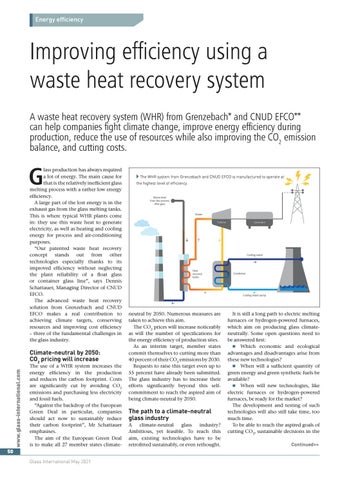Energy efficiency
Improving efficiency using a waste heat recovery system A waste heat recovery system (WHR) from Grenzebach* and CNUD EFCO** can help companies fight climate change, improve energy efficiency during production, reduce the use of resources while also improving the CO2 emission balance, and cutting costs.
G
lass production has always required a lot of energy. The main cause for that is the relatively inefficient glass melting process with a rather low energy efficiency. A large part of the lost energy is in the exhaust gas from the glass melting tanks. This is where typical WHR plants come in: they use this waste heat to generate electricity, as well as heating and cooling energy for process and air-conditioning purposes. “Our patented waste heat recovery concept stands out from other technologies especially thanks to its improved efficiency without neglecting the plant reliability of a float glass or container glass line”, says Dennis Schattauer, Managing Director of CNUD EFCO. The advanced waste heat recovery solution from Grenzebach and CNUD EFCO makes a real contribution to achieving climate targets, conserving resources and improving cost efficiency – three of the fundamental challenges in the glass industry.
www.glass-international.com
Climate-neutral by 2050: CO2 pricing will increase
The use of a WHR system increases the energy efficiency in the production and reduces the carbon footprint. Costs are significantly cut by avoiding CO2 emissions and purchasing less electricity and fossil fuels. “Against the backdrop of the European Green Deal in particular, companies should act now to sustainably reduce their carbon footprint”, Mr Schattauer emphasises. The aim of the European Green Deal is to make all 27 member states climate-
� The WHR system from Grenzebach and CNUD EFCO is manufactured to operate at the highest level of efficiency.
neutral by 2050. Numerous measures are taken to achieve this aim. The CO2 prices will increase noticeably as will the number of specifications for the energy efficiency of production sites. As an interim target, member states commit themselves to cutting more than 40 percent of their CO2 emissions by 2030. Requests to raise this target even up to 55 percent have already been submitted. The glass industry has to increase their efforts significantly beyond this selfcommitment to reach the aspired aim of being climate-neutral by 2050.
The path to a climate-neutral glass industry A climate-neutral glass industry? Ambitious, yet feasible. To reach this aim, existing technologies have to be retrofitted sustainably, or even rethought.
It is still a long path to electric melting furnaces or hydrogen-powered furnaces, which aim on producing glass climateneutrally. Some open questions need to be answered first: � Which economic and ecological advantages and disadvantages arise from these new technologies? � When will a sufficient quantity of green energy and green synthetic fuels be available? � When will new technologies, like electric furnaces or hydrogen-powered furnaces, be ready for the market? The development and testing of such technologies will also still take time, too much time. To be able to reach the aspired goals of cutting CO2, sustainable decisions in the Continued>>
50 0 Glass International May 2021
CNUD.indd 1
17/05/2021 06:52:00


















